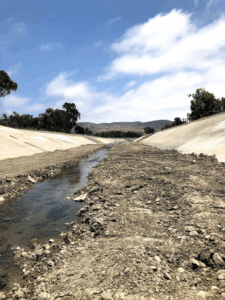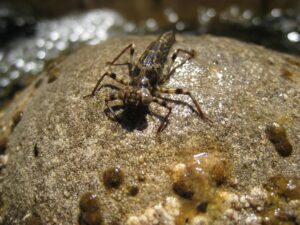Stream biointegrity workshop highlights scientific advances

A State Water Board workshop that focused on the appropriateness of taking a biology-based approach to regulating the health of streams in the San Diego region has highlighted the scientific foundation that SCCWRP has built for using bioassessment tools for routine aquatic monitoring – including SCCWRP’s work in recent years to address concerns and questions raised by stakeholders.
The workshop, held in Sacramento in May, centered around more than a decade of research by SCCWRP and its partners to help managers evaluate if policies known as biological objectives are ready to be used for protecting the health of California’s stream ecosystems. Regulators, regulated agencies and environmental advocacy organizations all engaged in robust policy debate during the workshop, with SCCWRP science serving as the foundation for the workshop.
In 2020, the San Diego Regional Water Quality Control Board became the first in California to develop a stream biointegrity policy that uses a bioassessment scoring tool developed by SCCWRP to assess water quality in perennially and intermittently flowing streams across the San Diego region. The policy would apply to all natural and engineered channels with soft or natural streambeds, but would exclude streams that are deemed “fully hardened” as a result of being lined with concrete, rock and similar materials.
The policy must be approved by the State Water Resources Control Board before it can go into effect. Thus, the May workshop served as a mechanism for the State Water Board to gather information prior to bringing the San Diego Regional Board’s policy forward for State consideration.
Unlike traditional chemistry- and toxicology-based monitoring of stream health, stream bioassessment tools focus on assessing the health of biological communities that are sensitive to changes in stream water quality. These tools, which produce a single numerical score for stream sites, include two statewide indices co-developed by SCCWRP: the California Stream Condition Index (CSCI) and the Algal Stream Condition Index (ASCI).
But stakeholders have raised questions and concerns about the appropriateness of adopting a stream bioassessment-based approach across California’s diverse watersheds, including whether stream bioassessment tools are applicable statewide and whether streams that have been modified for flood control purposes have the capacity to support healthy biological communities.

Following the San Diego Regional Board’s decision to move forward with a stream biointegrity policy in 2020, SCCWRP launched a series of additional studies that were directly responsive to the concerns expressed by both regulated and regulatory stakeholders.
This body of work, which served as the scientific foundation for the State Water Board’s stream biointegrity workshop in May, has generated insights and perspectives that are directly responsive to stakeholder questions about the use of stream bioassessment tools in the San Diego region and beyond.
Key issues that SCCWRP science has helped address following the San Diego Regional Board’s 2020 action include:
- Modified channels: Streams that have been modified via the addition of hardened features, straightening and other changes to the channel’s natural morphology tend to receive uniformly lower bioassessment scores than other stream types. As a result, stakeholders have expressed concerns about setting biological objectives for modified channels, given that managers may lack effective options for improving bioassessment scores in modified channels (short of removing or extensively modifying the channel hardening features, which would be costly and could compromise flood control). Over the past few years, SCCWRP research found that bioassessment scores can improve when water quality is improved, although this relationship can be greatly diminished in hard-bottom channels and other modified channels (SCCWRP Technical Report #1434, #1437). Ongoing SCCWRP research is examining whether water-quality improvements alone (i.e., without channel restoration) can improve biological health, plus whether channel restoration positively influences bioassessment scores.
- Intermittent streams: The types of organisms that live in intermittently flowing streams can be significantly affected by natural stream drying, as some species lack adaptations to help them survive periods of dryness between flow events. As a result, stakeholders have expressed concerns that using bioassessment tools in intermittent streams could potentially misinterpret the absence of certain species in intermittent streams as signs of ecological degradation. Research conducted by SCCWRP over the past few years has found that across Southern California, intermittent streams have bioassessment index scores that are comparable to perennial streams, and moreover, the research found that low scores in intermittent streams can confidently be interpreted as signs of degradation. But in Northern California, intermittent streams may receive lower scores than their perennial counterparts, suggesting that poor bioassessment scores could reflect natural drying rather than signs of human-caused degradation. A recent SCCWRP study in the San Francisco Bay Area provided an example for how to minimize this risk by conducting comprehensive assessments that include both perennial and intermittent stream reaches (SCCWRP Technical Report #1419).
Although the State Water Board did not take any formal action following the workshop, the policy debate is expected to help frame potential future management discussions about the appropriateness of using bioassessment scoring tools as a regulatory mechanism for protecting stream health statewide.
For more information, contact Dr. Raphael Mazor.
More news related to: Bioassessment, Indices of Biotic Integrity, Top News